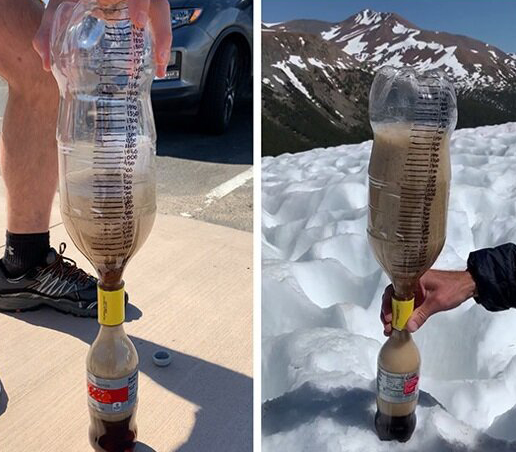Scientists Took Mentos And Coke to The Top of a Mountain, For Science
Adding pellets of Mentos mint candy to carbonated beverages has been a science fair staple for years. While most ten-year-olds can tell you why it spews up a geyser of foam, certain microscopic features of the reaction haven’t been so easy to figure out.
将曼妥斯薄荷糖颗粒添加到碳酸饮料中一直是”科学小演示”的常客。尽管大多数十岁的孩子都能说出为什么它会喷出泡沫状的间歇泉,但反应的某些微观原理却并非如此容易。
A chemistry professor at Spring Arbor University in the US joined forces with a Colorado high school teacher to map the reaction right at the crucial moment, revealing intricate new details on the sizes of bubbles that generate the fountain of fizz.
美国Spring Arbor大学的一名化学教授与科罗拉多州一名中学老师联手绘制了反应图,揭示了产生气泡的气泡大小的细节。
To do it, they went a little farther than the gymnasium or teachers’ car park. This experiment took them almost literally to the ends of the Earth, from Death Valley in California to the tip of Pikes Peak in the Rocky Mountains.
为此,他们不仅在体育馆或老师车库里试验,甚至走到更远的地方。这个实验他们几乎走到了地球的尽头,从加利福尼亚的死亡谷到落基山脉的派克峰顶端。
Thanks to its simplicity, safety, and low cost (not to mention popularity on early social media), the Mentos and Coke activity is a classroom perennial for demonstrating a variety of principles in chemistry and physics.
由于它的简单、安全、成本低(更不用说在早期社交媒体上的流行了),曼妥斯和可乐是常年活跃在课堂上用于展示化学和物理原理的。
At a basic level, the explanation behind the reaction is fairly straightforward: carbon dioxide is dissolved into Coke under pressure. Cracking the lid on the bottle changes the pressure, allowing some of the gas to fall out of solution and dissolve into the atmosphere according to good old gas laws.
从根本上讲,反应背后的解释很简单:二氧化碳受到压力而溶解在溶液中。随着瓶内压力的改变,根据气体定律,一些气体就从溶液中逸散出来并溶解到大气中。
Exposing more of the solution to the surrounding air allows more gas to escape (for example, if one were to shake the bottle); a Mentos candy just speeds this process up in a dramatic fashion.
将更多的溶液暴露在空气中会使更多的气体逸出(例如,如果要摇动瓶子);曼妥斯糖果以惊人的方式加快了这一过程。
Previous studies have shown that tiny pits in the candy shell provide the perfect traps for tiny air bubbles, so when one of those white discs sinks into the drink, its surface provides an expanse of air for dissolved carbon dioxide deep inside the bottle to rush into and fill.
先前的研究表明,糖果壳中的微小凹坑为微小气泡提供了理想的捕集阱,因此,当这些白色圆盘中的一个沉入饮料中时,其表面为瓶内深处的溶解二氧化碳提供了相当多的空气,冲入瓶内中并充入空气。
Until now, the exact size of those tiny nucleation bubbles could only be estimated based on micrographic images of the candy’s textured shell.
到目前为止,这些微小成核气泡的确切大小只能根据糖果带纹理的外壳的显微图像进行估算。
It’s not a trivial question, either. For carbon dioxide to leave the solution, each bubble needs to provide the right amount of surface area for plenty of gas to flow.
这也不是一个小问题。为了使二氧化碳离开溶液,每个气泡需要提供适量的表面积,以使大量气体流动。
Theoretically they need to be bigger than one micrometre across, but larger bubbles also take up more room, reducing the number of nucleation sites and potentially affecting the overall flow rate.
从理论上讲,它们的直径必须大于一微米,但是较大的气泡也会占用更多空间,从而减少了成核位点的数量,并可能影响总流速。
Since there’s no easy way to capture the moment visually, solving it demands some clever use of key relationships in physics, which means putting numbers to variables such as pressure and volume.
由于没有一种简单的方法可以直观地捕捉瞬间,因此解决这一问题需要在物理上巧妙地利用关键关系,这意味着需要对压力和体积等变量进行数值修正。
Spring Arbor University chemist (and self-proclaimed Mentos and Coke fan) Thomas Kuntzleman had noticed the reaction is far more dramatic when carried out at high elevations.
Spring Arbor大学化学家(自称为Mentos和Coke迷)Thomas Kuntzleman注意到,在高海拔进行时,反应要剧烈得多。
Back in 2018, Kuntzleman had a father’s day present he was keen to take advantage of. He had permission from his family to take his favourite experiment out on a country-wide road trip to run trials out in the real world.
早在2018年,Kuntzleman就收到了他渴望利用的父亲节礼物。他得到了家人的许可,可以在全国范围内进行他最喜欢的实验,以便在现实世界中进行试验。

“To do so, we carried out the experiment in many places around the US at altitudes that ranged from below sea level in Death Valley to over 14,000 feet (4,300 metres) at the top of Pikes Peak,” Kuntzleman told the science blog Improbable Research.
Kuntzleman告诉科学博客Improbable Research: “为此,我们在美国许多地方进行了该实验,海拔从死亡谷的海平面以下到派克峰顶的14,000英尺(4,300米)以上。” 。
“We had an absolute blast.”
“我们受到了极大的blast。”
Meanwhile, he roped in his science teacher buddy Ryan Johnson to conduct his own trials on the slopes of a mountain in Colorado. (You can see how much fun they had in Kuntzleman’s YouTube clip below.)
同时,他与他的科学老师哥们瑞安·约翰逊(Ryan Johnson)搭档,在科罗拉多州的一座山坡上进行自己的试验。。
They found that air pressure alone couldn’t account for their observations, leaving room to deduct finer variables that contribute to the foaming action.
他们发现,仅靠气压无法解释他们的观察结果,从而推断起泡作用的有更复杂的变量。
Combining data from variations in air pressure with measurements on the mass lost by degassing, along with comparisons between different candies, Kuntzleman and Johnson soon had a pretty good idea of why Mentos is a prime choice for this kind of activity.
将来自气压变化的数据与脱气后质量损失的测量结果结合起来,再加上不同糖果之间的比较,Kuntzleman和Johnson很快就很好地知道了曼妥斯为什么是此类活动的首选。
Their equations suggest those nucleation sites are between 2 and 7 micrometres across, a size that provides a fairly good compromise between bubble size and density of nucleation sites across the candy surface.
他们的方程式表明,这些成核位点的宽度在2至7微米之间,该尺寸在气泡大小和整个糖果表面成核位点的密度之间提供了相当不错的折衷。
Their conclusion is also a relatively close fit for micrographic pictures of the pits in the candy’s shell, building on existing models explaining the famous demonstration.
他们的结论也相对于糖果外壳上的凹坑的显微照片相对合适,其建立在解释著名演示的现有模型的基础上。
No doubt the results are great news for the Mentos marketing team as they come up with future slogans. But the real winners will be teachers looking for data to use in training their budding chemists and physicists.
无疑,结果对于曼妥斯营销团队来说是一个好消息,因为他们提出了未来的口号。但是真正的赢家将是寻找数据以训练他们崭露头角的化学家和物理学家的老师。
We can’t wait for the next generation of Mentos and Coke science fair posters!
我们非常期待下一轮的Mentos和Coke科学博览会海报!
This research was published in the Journal of Chemical Education.